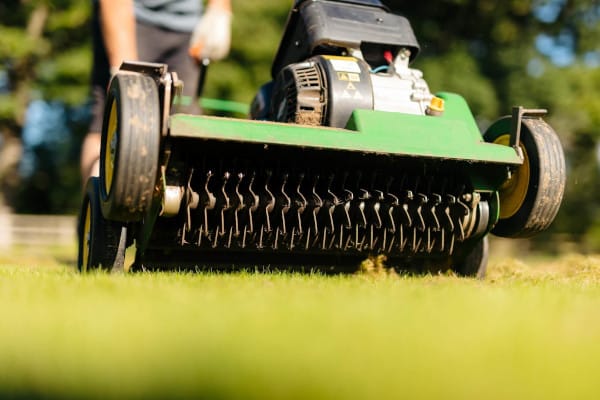Home / Information & advice / Turf & Lawns Advice / Lawn aftercare / Scarification
Scarification is a very important task to improve the quality of your lawn and increase the effectiveness of other lawn maintenance procedures.
Keep reading to learn how and why you should scarify your lawn in order to keep it looking beautiful.
The scarification process removes organic matter, such as thatch or moss, from around the base of the grass plants and tidies up any straggly lateral growth, that will otherwise prevent good dense grass growth.
If you do not scarify, debris will build up and lead to other problems. For example, thatchy and mossy lawns will not be very wear or drought tolerant.
Ideally scarification should be carried out in spring but it is also effective if completed in autumn.
We recommend that scarification takes place ahead of other procedures, including top dressing, overseeding and applying fertiliser, for maximum effect.
Continue to mow on a regular basis both before and after scarification.

Scarification can be done using a spring-tine rake by vigorously pulling the rake through the grass sward. Electric scarifiers, available from local garden centres or DIY stores, make removing thatch very easy. Hand scarification is hard work. If you have a large lawn, it may be better to use a machine.
If you are left with a lot of loose material on the surface after scarifying, then you can use your mower to pick it up (as long as it has a collection box). It is also worth running the mower over the lawn just to tidy up any straggly ends left after the scarification process.
Once the space has been created around the base of the grass plants, the trick is to encourage the grass to fill the space. There are two important points to note here.
Firstly, do not scarify too early in the spring. It is important that the grass is growing fairly well and that any space created is filled by desirable lawn grasses. If growth is slow, there is a higher risk that the gaps will be filled with unwanted weeds or weed-grasses.
Secondly, actively encourage grass growth after scarification by overseeding and or fertilising.
Further lawn care advice can be found in our Information Centre. You can also sign up for lawn tips to receive regular lawn care advice, news and promotional offers by email which will help you get the best from your lawn.
For more techniques to help you maintain a healthy lawn, explore our other lawn aftercare advice.
You can also sign up to our newsletter to receive free seasonal lawn care advice and reminders of essential maintenance, as well as general horticultural advice and special offers from Rolawn.